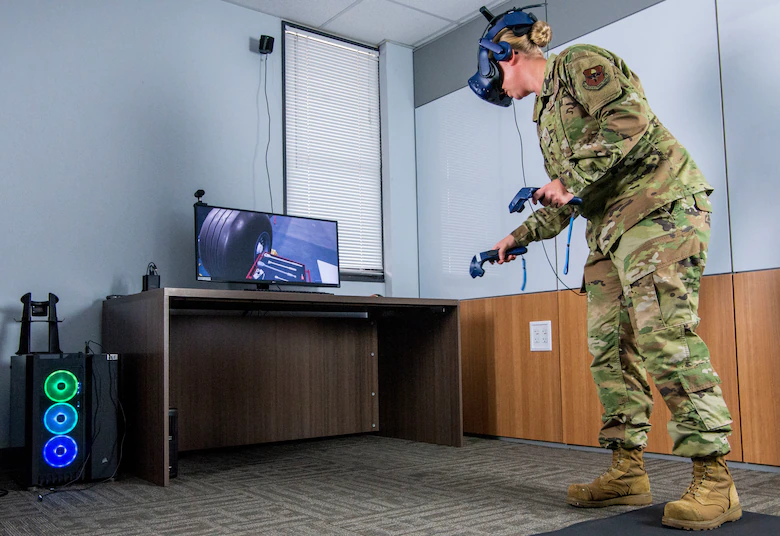
July 26, 2021 – The US Air Force has announced that its Air Education and Training Command’s (AETC) Tech Training Transformation team (T3 team), in partnership with officials at Sheppard Air Force Base, has re-engineered a foundational Crew Chief Fundamentals Course into a virtual reality (VR) experience.
The course began last year when 29 students donned VR gear and tried out the program, where they examined tools, maintained simulated aircraft and completed objectives, all within a 3D, on-the-job environment. According to the Air Force, the results were impressive, with students’ end-of-course scores within the program being comparable to those of students using traditional methods. Students also finished the course 46% faster, completing the 27-day course in just 12.5 days.
“It’s proven that T3’s program is an effective learning model,” said Senior Master Sgt. Toby Caldwell, 362nd Training Squadron assistant superintendent, who has been actively involved in overseeing T3’s training initiative at Sheppard AFB since the program’s beginning. “As we continue to meet the accelerate-change mission, we in the training environment are teaming up at the forefront of technological enhancements.”
In June 2021, T3 introduced an additional component to the program: non-player characters (NPCs). Students interact with AI Airmen by asking them questions and receiving instructions within the simulation. For example, a student maintaining an aircraft could have a conversation with an AI security forces Airman patrolling the flight line and learn about safety protocols or ask questions about the area.
The Air Force added that this AI interaction will allow students to essentially swap places with AI characters, meaning that an aircraft maintainer can learn basic flight line security from an AI security forces Airman, or a security forces Airman could enter the program and familiarize themselves with aircraft maintenance from AI. The AI system will also continuously measure a student’s ability to complete tasks and foundational competencies, and will track performance throughout an Airman’s career, not just during technical training.
Furthermore, the T3 team is developing and testing an app for courses that don’t require VR. In the future, this more student-centric learning model will allow Airmen to log in on a mobile device and begin consuming course information according to their preferred learning style, for example, through visual or audio-based course content. Along the way, the AI capability will personalize the program, providing suggestions such as: “You’ve listened to the lesson three times but still haven’t scored well on the assessment. Why don’t you try watching this video or completing this exercise instead?”
The Air Force added that these learner-centric initiatives and an improved training infrastructure will help to speed up the training pipeline by allowing Airmen to progress at the speed of learning, creating more well-rounded Airmen who are “better prepared for an era of great power competition”. Additionally, such initiatives will help to develop a more resilient training enterprise that can continue to operate in disrupted environments.
“We’re excited to continue utilizing virtual and augmented reality to enhance our technical training courses here at Sheppard AFB,” said Chief Master Sgt. Jason C. Groth, 82nd Training Group superintendent. “I think this type of training capability could also eventually be used to help train our multi-capable Airmen in austere locations.”
Plans are in place for two fully operational courses to launch at Sheppard AFB in 2022 with additional courses to follow. The two initial courses will be Crew Chief Fundamentals and Logistics Planning.
For more information on the Air Education and Training Command, click here.
Image credit: US Air Force photo by Staff Sgt Keith James
About the author
Sam Sprigg
Sam is the Founder and Managing Editor of Auganix. With a background in research and report writing, he has been covering XR industry news for the past seven years.




